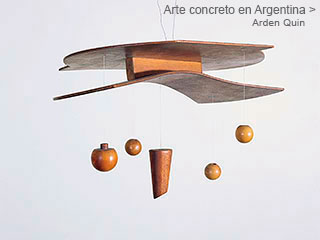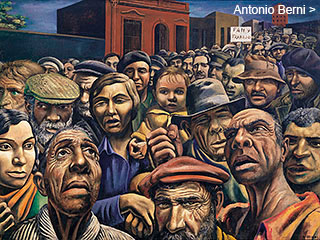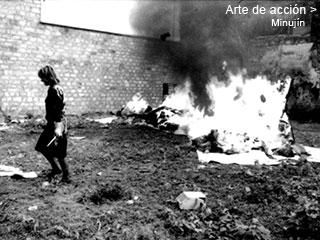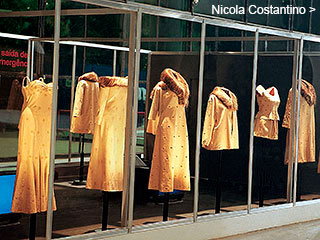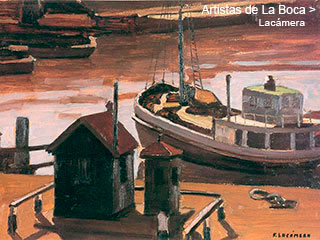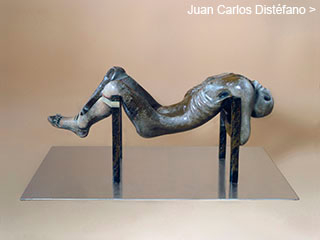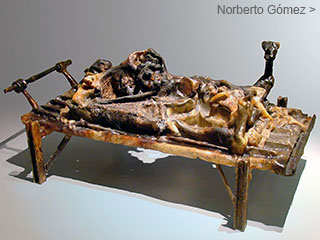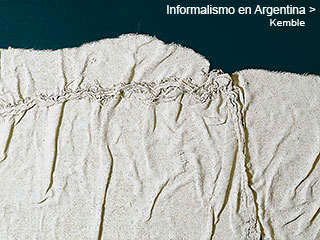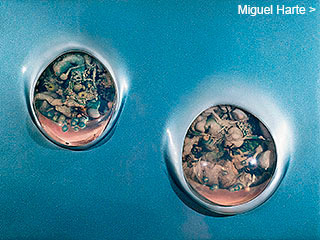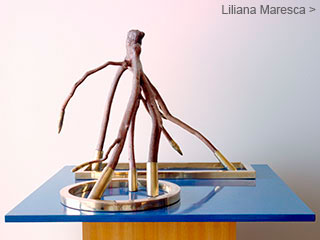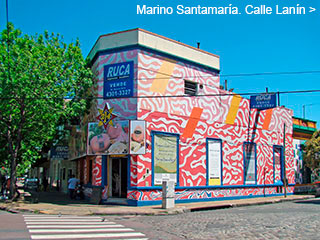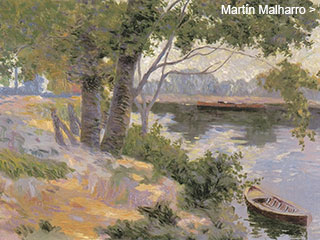Menú
Algunos dossiers
La Boca
Artists
Artists
by
Florencia Battiti and Cintia Mezza
August 2006
August 2006
We are about to venture into the fascinating world of the famed La Boca artists. This dossier reviews the gravitations of the modernization process of Argentine art throughout the last one hundred years, and the role that its growing cultural institutions played along the way. This investigative work has been authored by Florencia Battiti, and assisted by Cintia Mezza.
First representations
It is Charles H. Pellegrini, a Savoyard engineer and artist, who paints a series of water colors and lithographs, capturing for the first time a view of the riverside. Riachuelo and Primitivo Puente de Barracas (First Barracas Bridge) (1830), Barraca Peña and Vuelta de Rocha (1833), stand out among his work.
Pellegrini, a hydraulic engineer, arrived in Buenos Aires contracted by Bernardino Rivadavia. He was to develop a project to thin out the outlet of the Riachuelo by partially closing the exit with a floodgate, in order to increase its flow and solve the problem of the shallowness of the port.
Other works include colored lithographs titled Buenos Ayres and La Boca del Riachuelo cerca de Barracas that the Parisian printer Lemercier makes from drawings of D. Dulin, around 1860. At least two of them are shown at the Museo Histórico Nacional. This museum also houses Vista de La Boca a Buenos Aires, an engraving based on the drawings of P. Mousse and lithographed by A. Clairaux. We can also find anonymous work about La Boca, and numerous photographs of this place taken between 1900 and 1914.
Forerunners
The first artistic manifestations of the port activities in La Boca were represented by sculptors and filigree artists such as Francisco Parodi and Américo Bonetti.
From his atelier located on Martín Rodríguez St., the Genovese Parodi models figureheads as of 1860. These pulenas, as they were called in Ligur dialect,  are polychrome wooden figures placed on the bow of ships to ward off bad spirits or to encourage trust among the crew at the moment of sailing off to unknown destinies.
are polychrome wooden figures placed on the bow of ships to ward off bad spirits or to encourage trust among the crew at the moment of sailing off to unknown destinies.
Amércio Bonetti, born into a Swiss family, learns engraving and practises sculpturing at his father’s cabinet making workshop. He also receives elemental training at Parodi's atelier.
Although he develops most of his work in La Boca, he moves to the north of the country where he carves wooden animals and typical local characters. Upon his return, he starts making religious sculptures. Among them we find Cristo (Christ) displayed at San Pedro (St. Peter’s Church), and San Juan (St. John) displayed at San Juan Evangelista (St. John Evangelist Church), both located in La Boca.
Today, at the Museo de Bellas Artes “Benito Quinquela Martín”, we can see eighteen figureheads rescued from the old shipyards by Quinquela himself. Recently restored, they are displayed in an island like environment, with fish tanks and acrylic walls simulating a marine atmosphere. There we can see El Angel de la trompeta (1889) and Greca Latina (1887), both by Américo Bonetti, at the salon that bears his name.
Born in La Boca
Francisco Cafferata Monumento al Almirante Brown, 1886
Francisco Cafferata
Cabeza de esclavo
c. 1882
Cabeza de esclavo
c. 1882
Francisco Cafferata is the first Argentine sculptor born and bred in La Boca. He was educated in an academic atmosphere where he acquires knowledge about the principal typologies of public sculpturing. At a very early age, he studies drawing with Julio Lagues and in 1877, he travels to Florence to attend the workshops of Urbano Luchessi and Augusto Passaglia, representatives of the XIX century ecclesiastical sculpturing movement. During his stay in Italy, he makes the Monumento al Almirante Guillermo Brown, local naval hero who won the Battle of Juncal. Upon his return to Buenos Aires in 1885, he brings back with him the bronze statue that is embedded the following year at a plaza in Admiral Brown´s birth place (known today as the city of Adrogué). It becomes the first pubic monument built by an Argentine artist.
In Buenos Aires, at the Exposición Continental of 1882, Cafferata shows Esclavo (Slave) (c.1882), one of his most representative pieces due to its expressive power and its depurated technique. Winner of the Gold Medal, the sculptor represents a black slave, naked and chained, sitting on his hips with his legs bent and leaning on his right hand. His face reflects his obvious fatigue during an apparently short rest. Even though Cafferata adheres to academic norms, his work denotes interest for naturalistic representation, particularly reflected in the chosen pose and the suggestive treatment of the character’s facial expression. This piece is currently embedded in Parque 3 de Febrero, in the city of Buenos Aires.
At the same time, Cafferata makes busts of national figures such as Rivadavia, Manuel Belgrano, Mariano Moreno, Bartolomé Mitre, the poet José de Espronceda and the painter José Bouchet. He hadn’t turned 30 yet, when he commits suicide in Buenos Aires. He was sculpting the figure of the black man, Falucho, a job that had been commissioned to him. The monument is dedicated to Antonio Ruíz –a soldier of the Rio de la Plata del Ejército Libertador army who had refused to render honors to the royal flag, and was executed in 1824– and is finished with some modifications by Lucio Morales. It is currently found embedded in Plaza Falucho in Palermo neighborhood.
Taking a turn away from the rigid eclectics of the XIX century, Pedro Zonza Briano, was born at the intersections of Brown and Suarez streets. Together with Rogelio Yurtia, he takes part in the modernization of the sculpturing process in our country. He is influenced by the work of Auguste Rodin, and in particular, by the Italian Medardo Rosso. Before parting to Europe in 1908, he studies with Lucio Correa Morales. In 1911, Zonza Briano goes to Italy where he works on a group of sculptures called El pensamiento helénico (The Hellenic thought), and on three nude virile men of natural size that José L. Pagano formally relates with Los burgueses de Calais, by Rodin.
Other sculptures made by Zonza Briano in Europe are: El Origen de las pasiones (The Origin of Passions) (1909) and Así habló Zaratustra (Such spoke Zaratustra) (1910).
In 1912, at the Salon de París, he presents Creced y multiplicaos (Grow and multiply) (1911), two nude bronze figures –a man and a woman– fused together in an erotic embrace. This piece causes great commotion and is taken down from the exhibition by the French police. A year later, the same piece obtains the Acquisition Award at the Salón Nacional, becoming a patrimony of the Museo Nacional de Bellas Artes.
In works such as Boca de Fuego (Mouth of Fire) (1916), Zonza Briano explores the possibilities of the composition and applies the “non finito” technique –non-finished– achieving contrast and modulation between plain and irregular surfaces.
Among the works of art that are embedded in public places, it is important to mention the Monumento a Leandro Alem (1842-1896), inaugurated in 1925. It represents the politician with his left arm extended and his chest turned to the back, in a passion filled political speech. The monument is completed with two smaller figures, a female with two children representing the Homeland, and a young male representing his own political party (Juventud Radical).
* * *
Juan A. Chiozza, José Luis Menghi, José Desiderio Rosso, the Orlando and Santiago Stagnaro brothers, Miguel Diomede, among others were born and developed their work in La Boca del Riachuelo. They will come together towards the 1920’s, to form the El Bermellón group.


